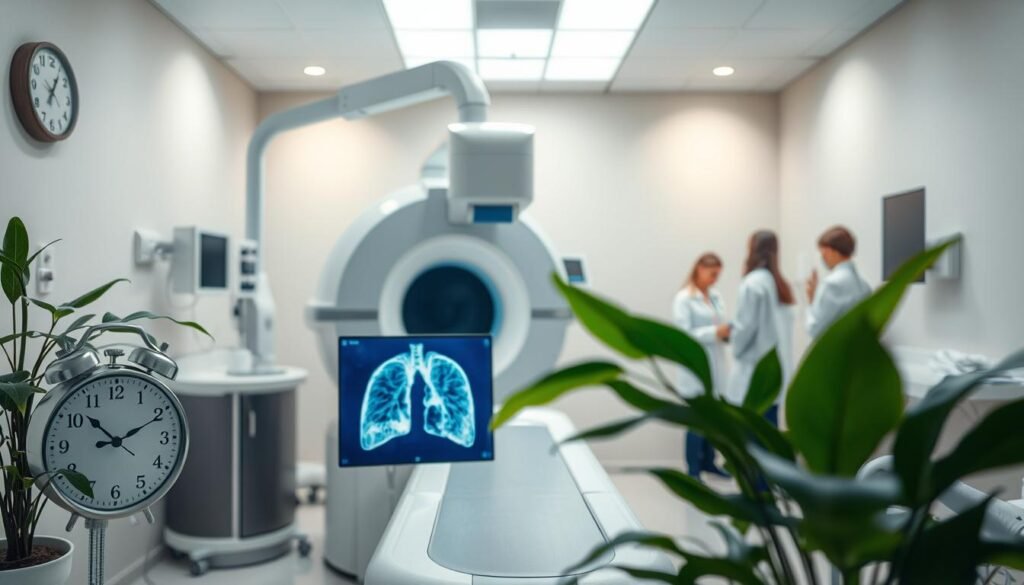Did you know that your risk for lung cancer can drop a lot within just five years of quitting smoking? This shows how important Tobacco-free Living is for Lung Cancer Prevention. Smoking is the top cause of lung cancer and many diseases related to smoking. But, the good news is quitting smoking has huge benefits for your health. People who stop smoking not only cut their lung cancer risk. They also improve their overall health a lot.
Quitting smoking opens up many health benefits and can lead to a longer, healthier life without tobacco’s dangers. This article shares tips and lifestyle choices to further lower your lung cancer risk after you’ve stopped smoking.
If you want more info, resources like lung cancer risk assessments and programs that help you quit can be very helpful.
Key Takeaways
- Quitting smoking greatly lowers your risk of lung cancer.
- This risk goes down more and more over time after you quit.
- Regular doctor visits can help find and address issues early.
- It’s really important to live healthily after you stop smoking.
- Programs that help people quit smoking are very important.
The Importance of Quitting Smoking
Choosing a life without smoking brings huge health rewards and helps you live longer. People who stop smoking see big health changes soon after their last smoke. In just hours, oxygen and blood flow get better. This improvement paves the way for more health benefits over time. Quitting smoking is beneficial at any age, as research supports.
The Health Benefits of Smoking Cessation
Quitting smoking could add up to ten years to your life. It’s a key step for healthier living. Those who quit not only live longer but also have a better life quality. For example, their breathing improves and they have a lower chance of heart problems. Health gets better within days.
This shows how fast Smoking Cessation Benefits can start to happen. By quitting, you gain:
- Lung cancer risk drops by 42%
- Liver cancer chance goes down 27%
- Stomach cancer risk decreases by 14%
- 20% less risk of colorectal cancer
Statistics on Smoking-Related Diseases
Data shows the serious risks of smoking, urging people to Quit Smoking Support. Around 480,000 deaths each year in the U.S. are due to smoking. This includes lung cancer, heart issues, and stroke. Studies indicate that people who stopped smoking lower their cancer risk by 17%. Here’s a summary of vital stats:
| Statistic | Current Smokers | Former Smokers |
|---|---|---|
| 3-year survival rate | 66% | 75% |
| 5-year survival rate | 49% | 61% |
| Lung cancer risk reduction | — | 42% |
| Overall cancer risk reduction | — | 17% |
Quitting smoking brings positive changes at any stage of life. Those looking for help can find support for smoking cessation online. Health benefits start quickly and reward those who choose a smoke-free life.
How Quitting Smoking Reduces Cancer Risk
Smoking is a leading cause of lung cancer, linked to 87% of cases in the U.S. But there’s hope. Quitting smoking can drastically lower your cancer risk. When you stop, your body starts to heal. This healing can prevent lung cancer and reduce health risks over time.
The Link Between Smoking and Lung Cancer
Studies show a clear link between smoking and lung cancer. Smokers are much more likely to get this disease. However, quitting cuts your risk a lot. For instance, 10 years after stopping, lung cancer risk is halved. This highlights quitting as a key Lung Cancer Prevention method. Giving up smoking is vital for those worried about health and cancer risks.
Long-Term Effects of Smoke-Free Living
Quitting smoking has many long-lasting perks. Quit pens gain up to 10 extra years of life and a big drop in cancer deaths. Risks for other diseases, like heart issues, also sharply fall. Quitting young, between 15 to 34, dodges almost all cancer death risks from smoking. Considering the lasting health effects of smoking, quitting is critical.
It’s crucial for smokers to find help to quit and live healthier lives. The benefits of quitting are clear and powerful. For more details on quitting benefits, check out the studies here. Or learn about lung cancer screening at this link.
Reduce Risk of Lung Cancer After Quitting Smoking
Quitting smoking is a big step in cutting down lung cancer risk. In ten years, the risk drops greatly, almost like someone who never smoked.
Impact of Time on Lung Cancer Risk
Within five years of quitting, former smokers see their lung cancer risk drop by 39.1%. This risk keeps getting lower over time. However, even after 25 years, they still face higher risks than non-smokers. Lung Cancer Screening early on catches problems before they grow big, offering a better chance at beating the disease.
Comparative Risks of Former vs. Current Smokers
Smoking is a major cause of lung cancer, with current smokers facing the highest risk. 85% of lung cancer in the U.S. is tied to smoking. But, people who’ve quit smoking are much less likely to get lung cancer. 42% of lung cancers found in screenings are in those who quit smoking. Knowing the risks, former smokers are more likely to stick to being smoke-free and get checked often. This could help save over 12,000 lives a year.
| Group | Lung Cancer Risk | Screening Benefits |
|---|---|---|
| Current Smokers | High | Limited effectiveness without cessation |
| Former Smokers (within 5 years) | 39.1% reduced risk | Early detection potential with screening |
| Former Smokers (25 years post-quit) | Threefold risk compared to non-smokers | Continued need for regular screenings |
Healthy Lifestyle Changes for Lung Health
Changing your lifestyle is key to better lung health and lowering cancer risk. Regular exercise and eating well are the base of good health. By working out and eating healthy, you help your lungs and improve your overall health.
Importance of Regular Exercise
Physical activity has lots of benefits, such as reducing lung cancer risk. People who exercise regularly are less likely to get lung cancer, even those who used to smoke. Try to do moderate exercises like brisk walking for at least 150 minutes a week to help your lungs and feel better overall.
Nutrition’s Role in Cancer Prevention
Eating right is crucial in fighting off cancer. A diet with lots of fruits, veggies, and grains is full of antioxidants which protect against lung cancer. Avoiding foods high in bad fats and opting for those rich in vitamins E, lycopene, selenium, and beta-carotene helps keep lungs healthy. Choosing the right foods makes a big difference in your body’s ability to resist cancer.

Respiratory Health Post-Smoking
When you quit smoking, your lung health starts getting better right away. Your lungs begin to heal. You’ll notice airflow gets better and your oxygen levels go up. This makes lung capacity better over time. Depending on how long you smoked, full lung recovery could take months to years.
How Lungs Recover After Quitting
Right after you stop smoking, your lungs start to fix themselves. They clear out all the bad stuff from smoking. This is key for your lungs to get healthy again. People will start to see benefits soon. Their lungs work better and fight off germs better, too. Not smoking for longer times means you’re less likely to get lung cancer. It shows why sticking with it matters a lot.
Staying Active for Lung Function Improvement
Being active is really good for your lungs. Things like walking, swimming, or biking make your lungs stronger. This helps you breathe better all around. If you keep moving, your lungs heal faster after you quit smoking. Doing these activities often keeps your lungs in good shape for the long run.
| Activity | Duration (minutes) | Benefits for Lungs |
|---|---|---|
| Walking | 30 | Improves airflow and fitness |
| Swimming | 30 | Enhances lung capacity and strength |
| Cycling | 30 | Promotes endurance and respiratory function |
Doing these things is key for your lungs to heal and to be healthy. Keeping your lungs in mind helps you get better and stay that way. It shows us that with hard work and the right choices, recovery isn’t just possible—it’s within reach.
Quit Smoking Support and Resources
Getting help to quit smoking boosts your chances of quitting for good. There are many programs and counseling options that can offer the support and advice you need. Organizations like the American Cancer Society have special programs. These programs are made to help different people in their own unique ways.
Cessation Programs and Counseling
Programs and counseling are key to quitting smoking. They provide:
- Personalized counseling sessions focusing on behavioral change.
- Access to educational resources that inform on the dangers of smoking and benefits of quitting.
- Nicotine replacement therapies and prescription products to aid in the quitting process.
- Support hotlines that provide immediate assistance.
Finding Local Support Groups
Local support groups can make a big difference in your quitting journey. Sharing your struggles and successes with others can really help. Here’s how you can find groups near you:
- Check with local health departments and hospitals for recommendations.
- Visit websites dedicated to tobacco cessation that provide links to community groups.
- Engage with online forums and social media groups focused on smoking cessation.

| Resource Type | Description | Examples |
|---|---|---|
| Hotlines | Immediate support and guidance | 1-800-QUIT-NOW, 1-855-DÉJEALOQUER (French) |
| Apps | Tracking quitting progress and providing tips | QuitGuide, Smoke Free |
| Local Groups | Peer support for motivation and success | American Lung Association’s local chapters |
| Online Resources | Access to information and virtual support | Cancer.org, Smokefree.gov |
Recognizing Secondhand Smoke Exposure
It’s crucial to understand how dangerous secondhand smoke is for our health. This smoke comes from burning tobacco and harms not just those who smoke, but also those around them. It can cause serious health problems like lung cancer, heart disease, and breathing issues.
Health Risks of Secondhand Smoke
Being around secondhand smoke can lead to many health problems. For non-smokers, it raises the risk of heart disease and stroke. It also makes them more likely to get different kinds of cancers. Every year, secondhand smoke causes nearly 34,000 non-smokers to die early from heart disease.
This smoke is especially bad for babies and kids. It can cause sudden infant death syndrome (SIDS), lung infections, and worse asthma. It can also stop their lungs from growing properly, leading to lifelong breathing problems.
Creating a Smoke-Free Home Environment
Making your home smoke-free is key to avoiding these risks. Here’s how to make a healthier home:
- Make a rule that no one smokes inside.
- Ask guests to follow your home’s no-smoking rule.
- Set up smoking areas outside, away from doors and windows.
- Push for no-smoking rules in places your community shares.
By doing these things, families can greatly lower the risk of secondhand smoke exposure. This helps keep everyone healthier now and in the future.
The Importance of Early Cancer Detection
Finding lung cancer early can greatly improve how well treatments work. Lung cancer leads in causing cancer-related deaths. So, spotting it early is key to saving lives. Regular checks are vital. They help find lung problems early, making timely help possible.
Lung Cancer Screening Recommendations
In 2021, the U.S. Preventive Services Task Force (USPSTF) shared new advice on lung cancer checks. If you’re 50 to 80 years old and have smoked a lot for many years, you should get checked every year. They use a special low-dose CT scan, which improves the odds of finding cancer early. This can lead to better results if you get sick.
| Criteria for LDCT Screening | Details |
|---|---|
| Age | 50-80 years |
| Smoking History | 20 pack years |
| Screening Frequency | Yearly |
| Insurance Coverage | Most plans cover screenings with no deductibles or co-pays |
How Regular Check-Ups Benefit Former Smokers
Regular doctor visits help people who used to smoke. Talking with a doctor about your specific needs can create a custom check-up plan. If you used to smoke, getting checked regularly can find problems early. This can make a big difference in getting better. Those who stop smoking and get screened lower their risk a lot. It shows how important these lung check-ups are.

Monitoring Environmental Risks
Understanding environmental risks is key for lung health. Toxic substances can sharply raise lung cancer risk. Radon gas is dangerous. It’s second only to smoking as a lung cancer cause in the U.S. Testing homes for radon is crucial for safety.
Understanding Radon Gas and Lung Cancer
Radon is a harmful gas from the ground. It’s both colorless and odorless. Uranium in soil can lead to high indoor radon, which is risky. About 30% of lung cancer deaths in non-smokers are due to radon. It’s vital to test homes regularly.
Testing Your Home for Toxicity
It’s important to check your home for radon and other toxins. Radon test kits are easy to find at hardware stores or online. If radon is high, experts can lower its levels. Checking for lead, asbestos, and air pollutants is also key for lung health.
| Toxic Substance | Health Risks | Testing Methods |
|---|---|---|
| Radon | Lung Cancer | Radon test kits |
| Asbestos | Asbestosis, Lung Cancer | Professional inspection |
| Lead | Neurological Issues | Lead test kits |
| Indoor Air Pollutants | Respiratory Issues | Air quality monitors |
Being proactive by testing your home for toxins lowers lung cancer risk. Knowing the risks and taking action is the way to a healthier home.
Conclusion
Quitting smoking is a big step to cut down lung cancer risk. Studies show even heavy smokers see benefits after they quit. For example, five years after quitting, their lung cancer risk drops 39 percent.
Reducing how much you smoke also helps lower cancer risk. This shows the benefits of leaving behind tobacco use.
Living healthily boosts lung health. This means exercising regularly and eating right. These habits help your body recover and reduce cancer risk.
People who smoke less can also see their cancer risk go down. This is shown by hazard ratios that improve with reduced smoking.
Staying active in monitoring health helps your lungs stay strong. Using programs to quit smoking and doing health check-ups is key. Making the choice to quit smoking means investing in a longer, healthier future. It greatly lowers the risk of getting lung cancer later.